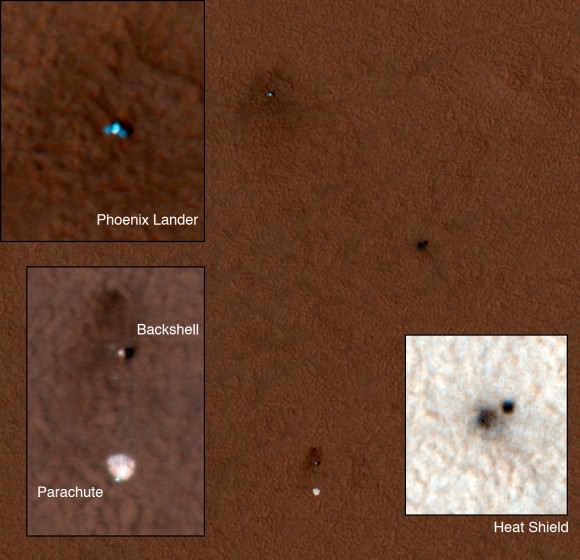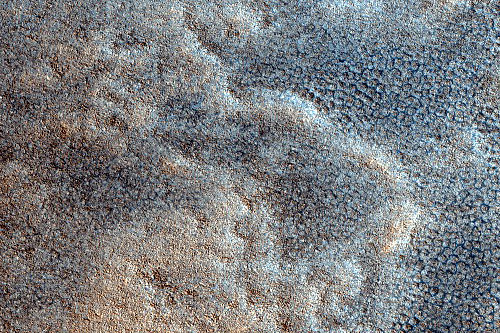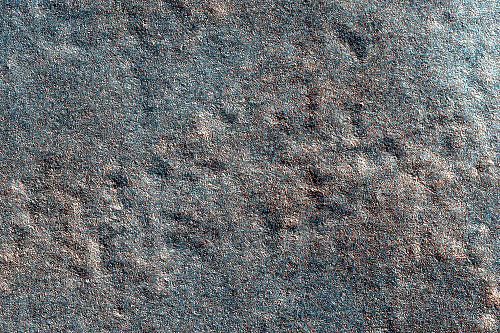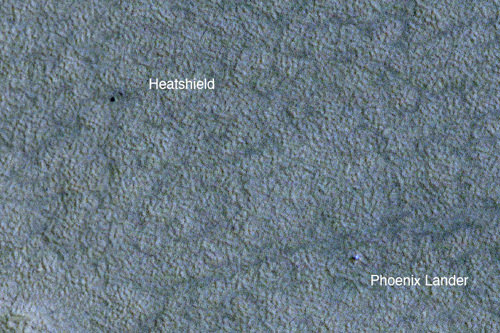[/caption]
The HiRISE Camera on board the Mars Reconnaissance Orbiter is keeping an eye on the Phoenix lander, and took the above image of the landing site on Dec. 21, 2008. Phoenix, its heatshield, parachute and backshell are still visible on the Martian arctic plains, providing evidence that the spacecraft hasn’t been covered with ice as of yet. Via the HiRISE Blog, scientists say the conditions are hazy and dark because northern winter summer is turning to autumn on Mars. They will keep imaging the site as long as there is enough light to see the lander. Compare this image to previous photos of the Phoenix site, below.

This color image was taken just after Phoenix landed in late May 2008. Insets show the backshell, parachute and heatshield.

In these images, top one taken in July of 2008, and bottom taken in October 2008, you can compare the lighting conditions between late summer and early fall, and now winter (first image) in the northern arctic regions on Mars.

Source: HiRISE Blog, HiRISE site
14 Replies to “Phoenix Not Covered With Ice — Yet”
Comments are closed.


For an extra 50 million, they could have installed an RTG that would have let us continue to get data all through the winter, including observations of this freeze over process. That would have been nice.
That winter data would have been nice to have but…
…Marvin the Martian or that Martian bunny would be getting on our case about trying to pollute their planet with a RTG. As it is, I think they might be plotting to swipe our rovers to use in some sort of Martian demolition derby…
…btw, just kidding.
Like I say though, the winter data would have been nice; I am glad that Phoenix had been as successful as it was.
Just an extra 50million?
lol thats alot of money
Not really. But I’d like to see some sorta evidence that it could be done that cheaply. Including some evidence that Pu was available when Phoenix was being built.
I think it is a little silly to speak of “polluting” an empty planet which is already heavily irradiated and unliveable for humans anyway. It’s a vast desert wasteland, and we’ll never get any science done by being so precious. Haven’t we wasted far more money and ROI by NOT including RTG’s?
But you need to remember Cassini. It’s the first hundred miles or so from *this* planet (and the thought that it might come back down on them) that gives some people fits, when trying to launch anything involving plutonium (or otherwise radioactive).
And this is so, no matter how much you do to show that it’s protected from dispersal in even the worst possible accident…
In Cassini’s case, you’re operating too far from the Sun. You need nuclear power of some sort. Period.
For Phoenix, you just admit the probe will be lost when winter sets in, instead of dealing with the anti-nuclear hysteria, just to get an additional few percent of operating time…
I expect to everyone’s surprise that the Martian winter cold will do no harm to Pheonix whatsoever, that in the coming summer the solar collectors will power up bringing pheonix back to life. Not that Pheonix will find Martian life ofcourse because there is’nt any. Nor is there any in the rest of the Universe or if there is it is not intelligent in any shape or form.
Here’s what I find interesting about the questions concerning RTGs or solar panel brushes. The probes under discussion were not expected to last as long as they did. That seems to be the recurring theme for our probes to Mars and elsewhere. Maybe the problem is that the guys in the unmanned probe part of NASA don’t realize how good they are. I would be willing to bet that Phoenix would have had an RTG and Spirit and Opportunity would have had solar panel cleaners if the teams had reason to believe that the products they made were so good. I just wonder how long the rovers would last if NASA had designed them to work for five years. The mission folks would retire before they gave out. Outstanding work by the design, launch, and operation teams for the Mars probes, Cassini, Galileo and all the others.
“Not that Pheonix will find Martian life ofcourse because there is’nt any. Nor is there any in the rest of the Universe or if there is it is not intelligent in any shape or form.”
Wow – you seem so sure… You must have some serious evidence that the rest of us don’t know about!
The images provided above are perfect for a quick read through this post.
Very nice.
Thanks for sharing.
Can’t wait til I get to go to Mars.
It should also be remembered that all of these landers/rovers have a maximum weight *budget* into which all systems, including experiments and sensors must fit.
RTGs weigh something. If you want to add one, what experiment(s) do you want to give up to make it possible?
Again, some probes have no choice about it, it’s in the nature of where they must go. In this case (and in addition to anti-nuclear controversy) it was better to go with solar panels only, and get the maximum science possible done in the time available, before damage from extreme cold and reduced electricity from low sun angles made further operations impossible.
As well it did.
Each Viking lander used 2 RTGs (each 15.2 kg to generate 42W electrical). Anyone know the power and weight of the solar panels and batteries on Phoenix ?
NASA doesn’t actually build spacecraft. NASA provides the specs to aerospace companies like Lockheed Martin (built the rovers and Phoenix), Ball, Boeing, etc. Those companies build the spacecraft. That they have lasted this long is a testament to the solid engineering these companies put into the design and construction. They are the people who should (but don’t) get the recognition deserved when these spacecraft outlive their expected life.
Adding an RTG would not be trivial. Phoenix was designed to be a cheap, throw-away spacecraft. An RTG to increase the usable life span of the spacecraft violates that principle, but it also implies that the rest of the spacecraft would have to survive longer. This increases cost all around, so it’s not just a matter of “adding an RTG for $50 million.”